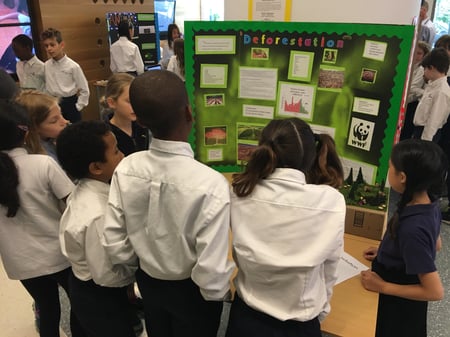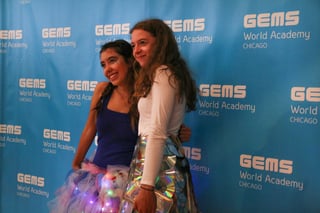THE SKILLS TODAY'S STUDENTS NEED TO BE LEADERS TOMORROW
Every year, global finance company Bloomberg conducts an exhaustive survey of recruiters to find out what skills are most in demand by employers, and what skills are the hardest to find in prospective employees.
The most recent report revealed a pressing need for six key skills:
- Analytical thinking
- Collaborative work styles
- Creative problem solving
- Leadership skills
- Strategic Thinking
- Communication skills
Of these, the bottom four are identified in the report as being particularly hard to find in prospective employees. While Bloomberg's report focuses on the business world, the specific skills listed this year are key to any number of fields, from the arts to STEAM-based professions. In a larger sense, the six skills create the foundation necessary for people to be informed next-generation citizens and global leaders.
Given the need for these skills, it's imperative that schools make it a point to develop them in their students. GEMS World Academy Chicago is committed to preparing students to be the innovators, change agents and leaders of tomorrow, and all six of the skills cited in the Bloomberg report are key components of the International Baccalaureate curriculum in place at our school.
1) Analytical thinking
One challenge for today's students is learning how to use the overwhelming amount of information that is available to them. The ability to access and analyze information constructively will help students develop analytical thinking skills. The real key is teaching them how to evaluate the sources of information and compare different sources of information to come up with the answer that makes the most sense in the real world.
 GEMS examples:
GEMS examples:
- • Eighth-graders, during a unit on the American Revolution, explored particular political or social debates from the time period. They researched the arguments made by both sides, paying particular attention to the validity of source material. Then, they acted out the debate using rap, in the spirit of the successful musical Hamilton.
2) Strategic thinking
Strategic thinking requires curiosity, imagination and the ability to consider long-term goals and challenges.
GEMS example:
- Our fourth-graders, during a unit on Energy, explored the idea that how we generate, store and transfer energy affects the environment in a number of ways. After engaging with architects in the community about energy-efficient design and auditing real homes for energy use, students developed a digital simulation of an energy-efficient city, taking into account the need for multiple energy sources, budget, etc. The students had to plan and establish goals while designing their city.
3) Creative problem solving
Not every problem has one right solution. Children need to learn how to look at problems from different angles, and prioritize solutions based on goals. Creative problem solving involves encouraging a child to combine skills they already have with new information to solve problems.
GEMS examples:
- The first grade's unit on Accessibility looked into how physical accessibility affects the manner in which people experience their environment. As part of this unit, students explored the notion of accessibility, particularly within the context of living spaces. They learned how people with disabilities navigate stairs, homes and modes of transportation. They analyzed their city's efforts with regard to accessibility. And they designed and created their own model buildings, incorporating solutions to accessibility issues.
- Our second grade completed a unit on Wants and Needs, which had students exploring how individuals and communities attempt to fulfill their wants and needs in different ways. Students learned about the concept of a marketplace. They then created and manufactured goods and "sold" them to one another, creating a classroom economy.
4) Leadership skills
 We can teach children that leadership doesn't always mean being the "boss." Today's great leaders don't define leadership in terms of telling people what to do. They talk more about being an inspiration — guiding and inspiring others to support a vision while leaving them feeling empowered. Today's educators can set up creative situations where students can learn the true meaning of leadership.
We can teach children that leadership doesn't always mean being the "boss." Today's great leaders don't define leadership in terms of telling people what to do. They talk more about being an inspiration — guiding and inspiring others to support a vision while leaving them feeling empowered. Today's educators can set up creative situations where students can learn the true meaning of leadership.
GEMS examples:
- Our Middle School produces a transdisciplinary fashion show each year. The event brings together science, design, technology and the humanities, as students design and create garments that reflect classroom inquiries and then model them for the school community. This year's event involved the entire Middle School — our sixth-, seventh- and eighth-graders — and the older students acted as mentors for their younger peers. The project requires students to work in groups and manage themselves, without the leader being "the boss."
5) Collaborative work styles
Today's world frequently requires that people with a variety of skills come together to work toward a common goal. Problems are complex, and it's rare that one person has all the answers. To thrive in that type of an environment, students must learn to collaborate.
GEMS examples:
- Collaboration is a key component of our approach to learning, so examples of it can be found in virtually every classroom during virtually every day. In addition to the big group projects mentioned in some examples above, students work together to gather data, formulate new questions, provide constructive feedback to one another and more.
6) Communication skills
Many children aren't natural communicators. They haven't developed the active listening skills that will help them respond appropriately to others. They haven't learned how to put themselves in the other person's shoes to choose the terminology and approach that will ensure their messages are being understood. Creative educators need to develop exercises that encourage effective communications, not just the ability to write grammatically correct sentences.
GEMS examples:
- Junior kindergarten devotes an entire unit to the concept of communication. Our students explore how ideas and emotions can be expressed in different ways. They learn how to identify their own emotions and share them with others. They also consider the connections between words we say and the reactions displayed by those hearing them.
- Our third-graders complete a unit on stories and storytelling. They explore folklore, myths and legends, focusing on how stories are structured and why. As part of the unit, students learn to identify the "rules" and objectives that underlie different types of stories, and they tell their own stories using different media and storytelling "tools."
The International Baccalaureate makes it a priority to teach students how to learn, and development of the six skills identified in the Bloomberg report is a big part of that effort. GEMS leaders believe these skills, as brought to life in the IB, position our students to take on important global-leadership challenges in the years to come.

